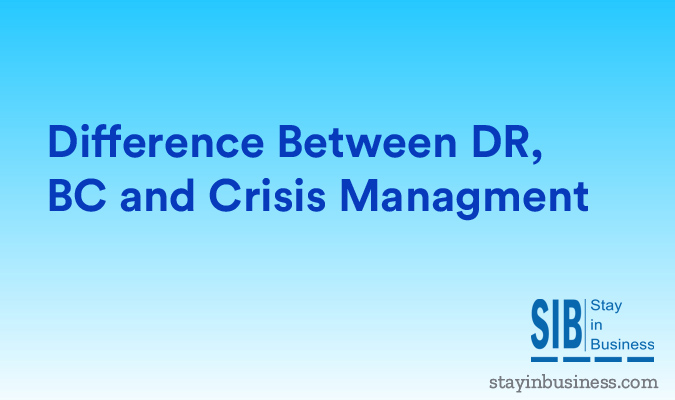DIFFERENCE BETWEEN DR, BC AND CRISIS MANAGEMENT (CM)

Difference Between Disaster Recover (DR), Business Continuity (BC) AND CRISIS MANAGEMENT (CM)
When a disaster strikes any business organization, three important aspects of managing the incident, recovering from the disaster and ensuring Business Continuity come into play. Though these terms are interrelated, they are different, as they attempt to do various functions as a part of the whole.
Crisis Management
Any disaster or disruptive event needs a Crisis Management Plan as a component of the overall Business Continuity Plan. The various aspects of Crisis Management Plan are:
- Defining a crisis
- Elements of a Crisis Management Plan
- How is a disaster declared
- Activating the Crisis Management Plan
What is a crisis?
A crisis can be defined as a disruptive event which affects a business’s facilities, IT systems, data, personnel etc. which leads to a stoppage in production. The halt in production will have a cascading effect on revenues, profitability, production schedules, business reputation, customer goodwill etc.
A crisis could be internal or external in nature. It could be a major crisis or a minor one. Depending on the severity of the crisis, the business may be exposed to adverse publicity. If it is a publicly traded business, the adverse publicity may drive down share value, leading to shareholder unrest. Therefore, a crisis should be handled in a very professional and competent manner.
Crisis Management Planning
A Crisis Management Plan is a part of the overall BC plan. The Crisis Management Plan contains the communication and decision-making components of the BC plan. A well thought of and documented Crisis Management Plan will facilitate communication between all stakeholders with safety considerations being paramount. It will also detail steps to be taken for impact assessment as also interaction with media regarding the crisis and action being taken to contain it.
Factors to be considered in a Crisis Management Plan
Since every business has different needs, one shoe does not fit all as far as Crisis Management Plan is concerned. However, common guidelines for a sound Crisis Management Plan are:
- Crisis Management Team – it should contain senior managers who have the expertise and experience needed to manage a crisis. The team should also consist of anyone with specialized knowledge useful in combating a crisis.
- Organizational responsibilities of the team – each member should be assigned a specific task by defining his functions, duties and responsibilities during a crisis.
- Sub-teams -this will function under the overall direction of the main team member. A sub team will have people with different types of expertise, who can handle the tasks associated with the crisis.
- Evaluation and corrections – after the conclusion of the crisis, assigned members should evaluate the response and take corrective action to overcome deficiencies.
- Contact list -a regularly updated contact list should be compiled to keep internal and external stakeholders in the loop.
- Command Center -a Crisis Management/Emergency Operations Command Center should be designated as the focal point for handling the crisis.
- Logistics – the logistical support for notification, mobilization and Manning of crisis centers should be clearly laid out.
- Public relations – in a time of crisis the last thing an organization needs is a ‘bad press’. A team member should be specifically assigned to this task.
Disaster Recovery
A DR Plan deals with the recovery procedures to be put in place when a disaster strikes. A multitude of significant events can halt production. Natural calamities, cyber attacks, fire, equipment sabotage, labor strife etc. can affect production. The Disaster Recovery Plan documents the procedures, policies and actions that limit the disruption and the steps that need to be taken for recovery. By making a careful impact assessment of various disasters on critical functions, steps can be taken to mitigate, reduce or eliminate the risks.
Business continuity
This aspect of disaster planning involves the processes and procedures a business should put in place to ensure that mission-critical business functions can keep operating during and after a disaster. The emphasis is on maintaining business operations rather than setting right the damage to infrastructure.
Crisis Management Plan, DR and BC Plans are interrelated but distinct. DR details of procedures and steps to recover from a disaster. Crisis Management Plan details are steps to be taken to handle the crisis. The BC Plan lists the steps to be taken to ensure continuity of mission-critical business operations. Crisis Management Plan and DR Plan are components of the overall BC Plan.
Categories: Business Continuity, Crisis Management, Disaster Recovery Planning, DR Plans
